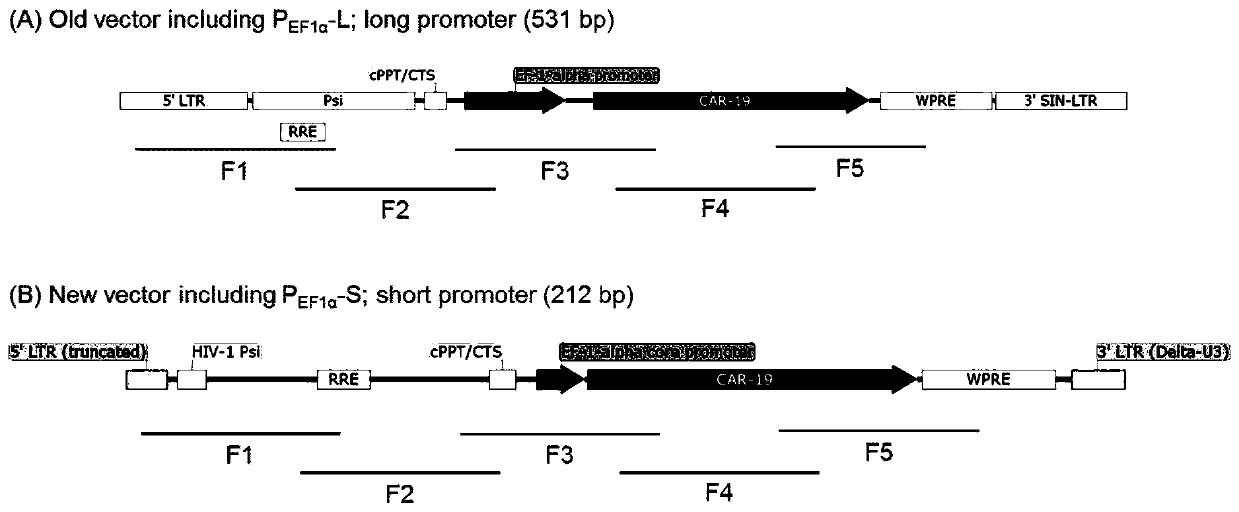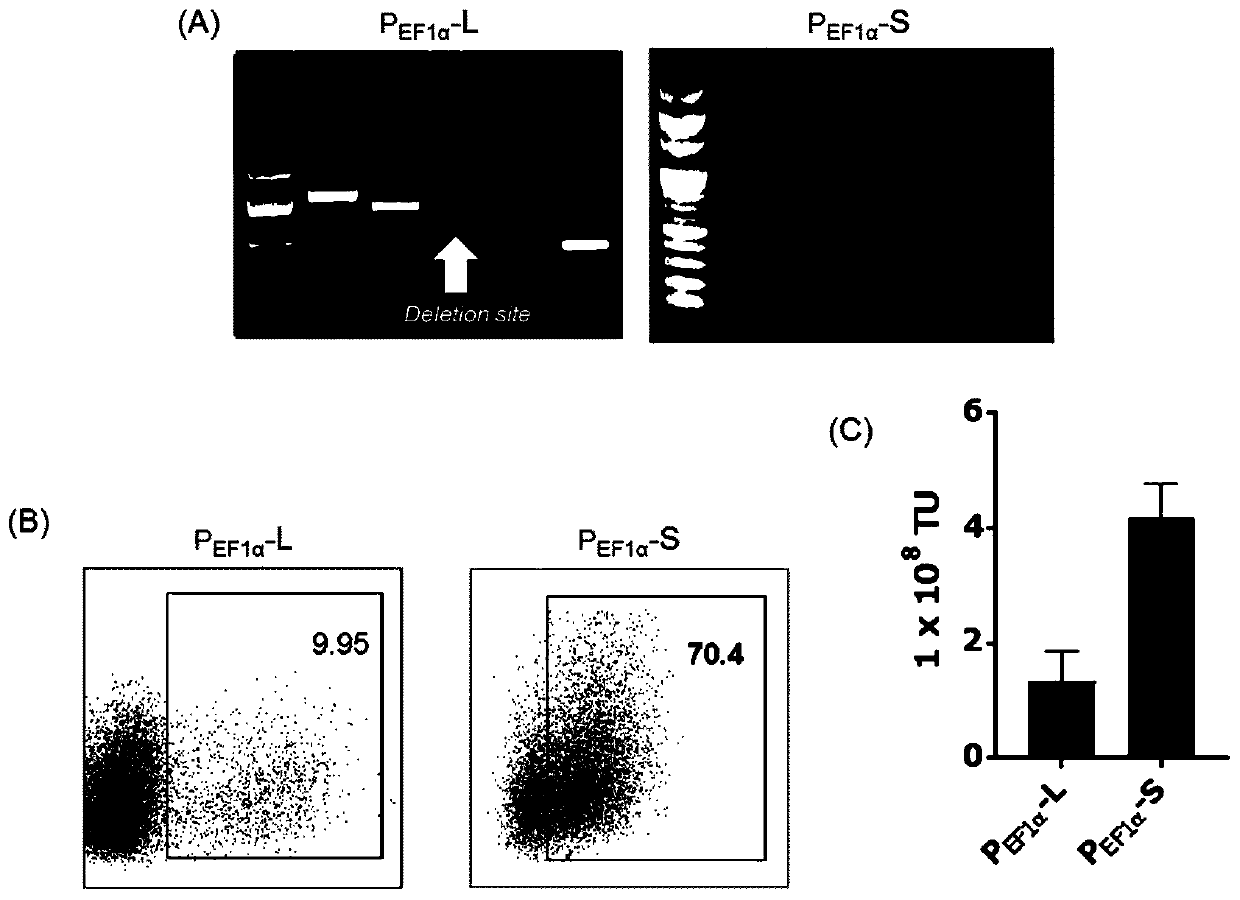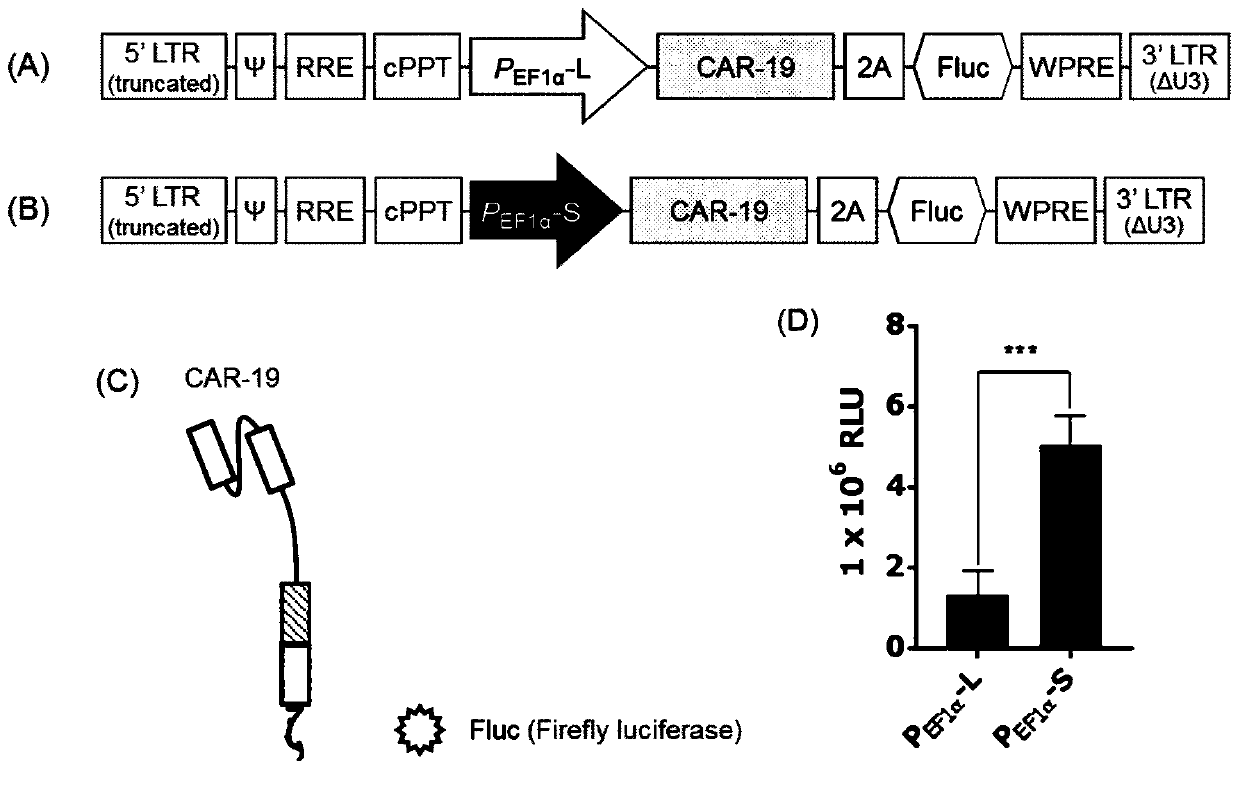Improved lentiviral vector
A lentiviral vector and receptor technology, applied in the field of biomedicine, can solve the problems of difficulty in meeting clinical needs and low co-expression efficiency of two proteins.
- Summary
- Abstract
- Description
- Claims
- Application Information
AI Technical Summary
Problems solved by technology
Method used
Image
Examples
Embodiment 1
[0063] Example 1. Optimization of lentiviral vectors for expressing CAR
[0064] The lentiviral vector used to transduce CAR should contain the desired CAR transgene and be able to express it in the cell. Two third-generation lentiviral vectors for CAR expression were designed, namely the old vector pPVLV1 ( figure 1 A) and the new vector pPVLV2 ( figure 1 B). pPVLV1 contains the 531 bp long human elongation factor 1 alpha (EF1 alpha) promoter and pPVLV1 contains the 212 bp truncated human EF1 alpha promoter. The various elements contained in the two vectors and their descriptions are found in Table 1 below.
[0065] The CAR to be expressed in the embodiment of the present application comprises scFv targeting CD19, hinge and transmembrane domain of human CD8, intracellular domain 4-1BB and CD3ζ. The amino acid of the CAR targeting CD19 is shown in SEQ ID NO:16, and the nucleotide sequence is shown in SEQ ID NO:8.
[0066] Table 1. Related elements on pPVLV1 and pPVLV2 len...
Embodiment 2
[0075] Example 2, promoter affects the transduction and expression of CAR gene
[0076] In order to further demonstrate the influence of different promoters, a pPVLV2-based image 3 Two CAR-luciferase reporter vectors, which differ only in the promoter driving the expression of the transgene, in which CAR-19 was cloned upstream of the P2A-Fluc (firefly luciferase) cassette, forming a bicistronic ( image 3 A and B).
[0077] After the vector is transduced into the cell, due to the presence of the coding sequence of the P2A self-cleaving peptide, two molecules, CAR-19 and luciferase, will be expressed in the same cell at a ratio of approximately 1:1, wherein the fluorescence intensity can be Reflects CAR-19 transduction efficiency (see image 3 C schematic diagram). image 3 D shows luciferase activity measured 48 hours after transduction of the two lentiviral vectors into 293T cells. The results show that with P EF1α The fluorescence of cells transduced with lentiviral ve...
Embodiment 3
[0079] Example 3, co-expression of CAR and DNRII in cells
[0080] TGF-β is an important T cell inhibitory factor, which may lead to the weakening or disappearance of the killing effect of therapeutic T cells on target cells. Clinically, TGF-β is widely expressed in a variety of tumor tissues and significantly inhibits the killing activity of tumor-specific T cells on tumor cells, which is an important reason for the failure of immunotherapy. The dominant negative TGF-β receptor type II (DNRII) is a negative regulatory receptor of TGF-β, which can inhibit the inhibitory effect of TGF-β on T cells. The following examples investigate the effect of co-expressing CAR and DNRII in T cells. The amino acid sequence of DNRII is shown in SEQ ID NO:17, and its nucleotide sequence is shown in SEQ ID NO:18.
[0081] First, similar to Example 2, a pPVLV2-based Figure 4 (A and B) Two CAR-19-DNRII vectors that differ only in the promoter driving transgene expression. Among them, CAR-19 ...
PUM
 Login to View More
Login to View More Abstract
Description
Claims
Application Information
 Login to View More
Login to View More - R&D
- Intellectual Property
- Life Sciences
- Materials
- Tech Scout
- Unparalleled Data Quality
- Higher Quality Content
- 60% Fewer Hallucinations
Browse by: Latest US Patents, China's latest patents, Technical Efficacy Thesaurus, Application Domain, Technology Topic, Popular Technical Reports.
© 2025 PatSnap. All rights reserved.Legal|Privacy policy|Modern Slavery Act Transparency Statement|Sitemap|About US| Contact US: help@patsnap.com



